No products in the cart.
NEWS
Phalaenopsis Orchid Care Guide: Grow Beautiful Moth Orchids
Elegant, beautiful, luxurious, and captivating – Phalaenopsis orchids, also known as Moth Orchids, are a favorite choice for decorating homes or giving as gifts, especially during special occasions. Not only do they boast a long blooming period, lasting from 2 to 3 months, but they also carry positive Feng Shui meanings. While these orchids aren’t excessively demanding, improper care can lead to pest issues or uneven, less-than-stunning blooms. As experts in horticulture, we’ll share essential tips for growing Phalaenopsis orchids to help you achieve abundant and beautiful flowers.
A Brief Look at Phalaenopsis Orchids
Phalaenopsis orchids, scientifically named Phalaenopsis Blume and often abbreviated as Phal in the trade, belong to the Orchidaceae family, the largest plant family. This genus includes around 60 different species. Phalaenopsis is one of the most popular orchid genera cultivated globally, loved and collected by many, and has been extensively hybridized into numerous varieties.
These are long-lived, perennial herbaceous plants that grow relatively slowly. With careful and correct care, they can live for over 18 years. Moth orchids are often found in humid tropical forests, originating from Southeast Asia, Australia, and the Philippines. Due to their beautiful flower shape and diverse colors, they are widely grown by enthusiasts of flowers and ornamental plants worldwide.
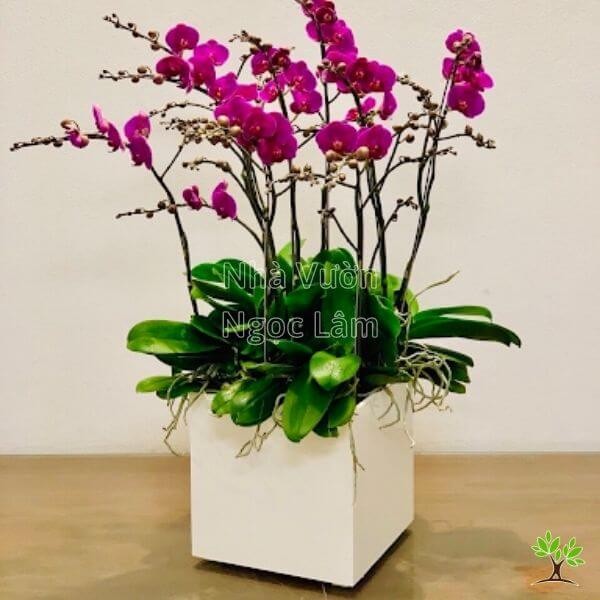 A collection of vibrant Phalaenopsis orchids in various colors like pink, white, and purple, showcasing healthy leaves and multiple bloom spikes
A collection of vibrant Phalaenopsis orchids in various colors like pink, white, and purple, showcasing healthy leaves and multiple bloom spikes
Typically, these plants grow epiphytically, attaching to long-lived woody trees or rocks. They have large, broad, somewhat succulent leaves. The flower stalks are slightly curved with many flowers blooming along a single stem, and the petals are symmetrically arranged. Some Phalaenopsis species have long flower stalks, while others have shorter ones. Flower colors are diverse and vibrant, including white, yellow, purple, pink, or petals with spots, edges, or multi-colored blends. Flowers usually bloom from December to May, with each blooming period lasting 2-3 months. With meticulous care, this can sometimes extend up to 6 months.
Each mature plant has about 5-10 leaves with many white aerial roots extending out to absorb moisture from the air. The optimal temperature for healthy growth is 20-35°C (68-95°F), ideally around 28-35°C (82-95°F) during the day and 20-24°C (68-75°F) at night. Suitable humidity levels range from 50-80%. These plants prefer shade and enjoy indirect sunlight, disliking direct sun exposure. Both roots and leaves can absorb nutrients for the plant.
Even under suitable conditions of weather, media, and water, it can take up to 40 days for a single leaf to fully develop. After propagation, a plant must have grown at least 5 leaves before it can bloom. For this reason, many flower lovers consider this species somewhat challenging to care for.
How to Grow Phalaenopsis Orchids
Moth orchids come in various plant shapes and sizes. Therefore, growers can pot each plant individually or group multiple plants in a larger container. A single pot can often hold several plants, and with good care, they can bloom within two years. During the planting and care process, you should keep a few points in mind:
- It’s best to grow orchids in a location with overhead cover, as this plant dislikes water pooling on its leaves, especially overnight. Water left on leaves overnight can lead to disease.
- This type of orchid blooms for a very long time, especially when cared for appropriately. A key condition for triggering blooming is a temperature around 18°C (64°F).
- Phalaenopsis prefers moisture but cannot tolerate waterlogging. These plants thrive in pots that are appropriately sized for their root mass – neither too large nor too small compared to the plant’s body.
Ideal Growing Media
The substrate used for growing Phalaenopsis orchids is critically important for the plant’s survival and normal development. The growing medium must ensure good aeration and drainage, while also retaining moisture well without becoming waterlogged. There are many popular types of substrates, such as coconut fiber/coir, charcoal, sphagnum moss, bark, pottery shards, or stones. Each type requires a different care and watering approach, so you should choose the one that best suits your conditions. A good and suitable substrate will provide the best growing environment for your Phalaenopsis orchid.
Charcoal – A Popular and Suitable Medium
 Phalaenopsis orchid growing in a pot filled with charcoal pieces
Phalaenopsis orchid growing in a pot filled with charcoal pieces
Growing Phalaenopsis orchids using charcoal has been a common practice for many years. Charcoal used for orchids is typically hardwood charcoal. When using charcoal, you generally only need to repot every 5-6 years, and the same pot size can often be used regardless of whether the plant is large or small. Some pests and insects harmful to orchids also dislike living in charcoal, which helps reduce root damage from insects. However, charcoal tends to retain salts and fertilizers, so you need to water thoroughly every 1-2 months to flush out accumulated salts.
To plant a Phalaenopsis orchid in charcoal, first layer the bottom third of the pot with charcoal pieces. Then, add a thin layer of finely chopped coconut coir. Place the plant in the pot as desired. Next, fill the rest of the pot with more coconut coir around the roots until it reaches about 1cm below the rim. Be careful not to compress the coir too tightly, but tap the pot gently to help the coir settle evenly. Water the plant immediately after potting.
If hanging orchids on a balcony, porch, or rooftop, consider placing other plants around them to reduce the effect of direct sun. Suitable companion plants could include palms, jasmine, or other small trees. The Phalaenopsis blooming season starts from December to late May. With good care, blooms can last about 3 months, some varieties last longer, and some can bloom year-round.
Growing Phalaenopsis Orchids with Coconut Husks
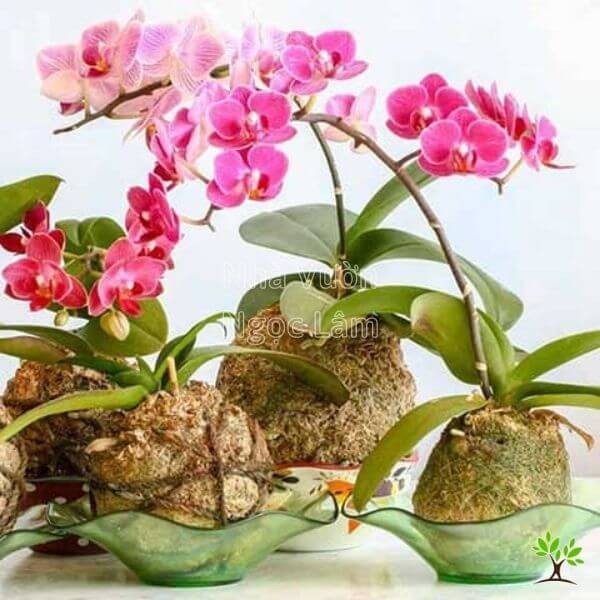 Closeup of a Phalaenopsis orchid plant with roots nestled among chunks of coconut husk
Closeup of a Phalaenopsis orchid plant with roots nestled among chunks of coconut husk
Dry coconut husks are also a very familiar material used for growing orchids. You can use coconut shells as pots, whole husks as both pot and medium, or chopped husks as a soil substitute. This material is inexpensive, readily available, and an important component in orchid cultivation and care. Coconut shells can serve as pots, whole husks can be both pot and medium, and chopped husks can replace traditional orchid potting mix.
When growing with coconut coir or husks, they can easily develop moss and decay after some time. They can also make the plant unstable due to their light weight. Therefore, if you choose to grow Phalaenopsis orchids using coconut coir, you must be mindful when watering. Furthermore, coconut coir contains salts, so it’s essential to soak it in water for about 3-4 days, rinsing thoroughly to remove salts before planting.
Covering the roots with a layer of coconut coir creates an insulating layer, keeping the roots cool and reducing water evaporation from the growing medium, ensuring the roots stay sufficiently moist. Additionally, chopped coconut coir mixed into the potting medium makes it more porous and airy, preventing compaction and promoting ventilation, which helps the plant develop well and stimulates root growth by providing nutrients present in the coir itself.
Growing Phalaenopsis Orchids with Sphagnum Moss
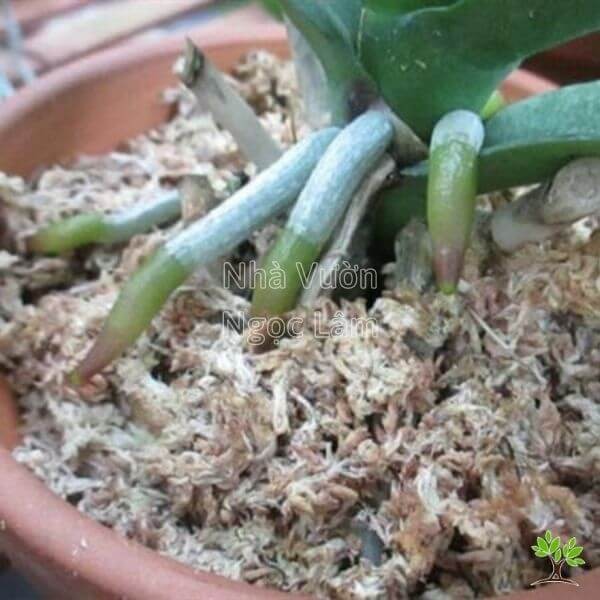 Phalaenopsis orchid plant potted in sphagnum moss in a clear plastic pot
Phalaenopsis orchid plant potted in sphagnum moss in a clear plastic pot
Moss is also a popular substrate for growing orchids, especially sphagnum moss. Sphagnum moss for orchids is produced in many countries, with the highest quality coming from New Zealand and China. Moss from other countries is often not as high in quality and is less commonly used.
Moss should ideally only be used in small pots from 4-10cm (1.5-4 inches) with many drainage holes. When using moss for orchids, the medium needs to be replaced annually. Before use, soak the moss in water for 24 hours to clean it. Do not compress the moss tightly in the pot to ensure good aeration. It’s best to add some pottery shards or small stones to the bottom of the pot for better drainage and aeration. When growing in moss, water only about once a week, wetting the moss thoroughly each time.
If you are mounting your orchid on a piece of wood or bark using moss, you will need to water more frequently, perhaps every 2-3 days.
Orchid species with very fine roots should generally not be planted in moss because the roots can become intertwined with the moss, making repotting very difficult. If you do use it for fine-rooted orchids, consider a mix, perhaps 3 parts chopped moss, 3 parts charcoal, 3 parts fern root, and 1 part perlite for drainage and easier repotting.
Orchid species that are sensitive to root disturbance or dislike high humidity are also not suitable for growing in moss.
Growing Phalaenopsis Orchids with Bark
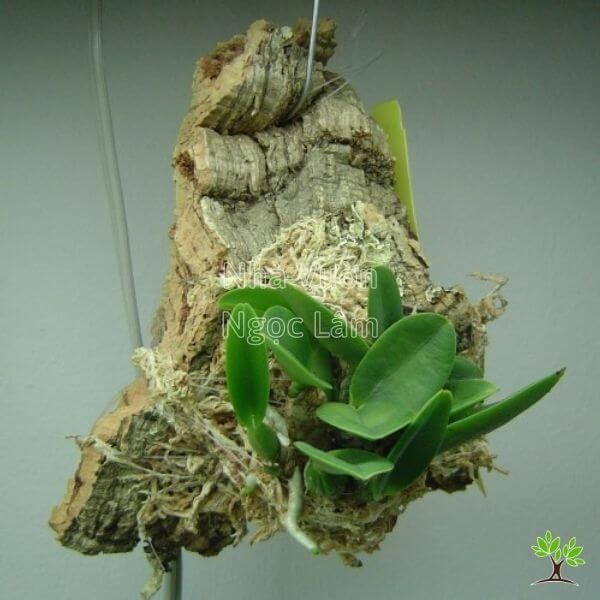 Phalaenopsis orchid potted in bark mix with visible roots
Phalaenopsis orchid potted in bark mix with visible roots
Bark has been used for growing orchids since ancient times. Many types of bark can be used for orchids, but it is best to choose types that are durable and resistant to decay. When growing with bark, you need to watch out for pests that like to live in it. If you notice signs of pests in the bark, it should be replaced. Pine bark is considered one of the most suitable types of bark because it contains resin, an active compound with high antibacterial properties, making it slow to decay and resistant to moss growth.
Light and Temperature Requirements
When growing Phalaenopsis orchids at home, they should be placed where they receive natural light but with protection from direct sun, such as on a balcony, near a window, in a garden area, or on a porch under cover. If growing in a location with strong sunlight, consider placing other plants around the orchids to provide shade and reduce heat exposure.
The time for the plant to flower is usually around early December, when the plant has four or more leaves and begins to develop a flower spike. The ideal temperature for triggering flowering is between 18-25°C (64-77°F), with the nighttime temperature not varying by more than 8-10°C (14-18°F) from the daytime temperature. Maintaining this ideal temperature range for a longer period will encourage more abundant flowering. However, temperatures below 15°C (59°F) or above 25°C (77°F) will inhibit bud formation and flowering.
Once a Phalaenopsis orchid is in bloom, simply placing it in a cool, well-ventilated spot with a temperature around 20-25°C (68-77°F) and avoiding direct sunlight will help the flowers last for a very long time.
Normally, the leaves of a healthy orchid are a slightly dark green. If the leaves become even darker, it indicates the plant is receiving too little light. If leaves develop brown spots or gradually turn reddish, it’s a sign of leaf burn, meaning the plant is getting too much light. Additionally, insufficient light can prevent the plant from flowering. To encourage blooming, you may need to provide supplemental light for 13-16 hours per day.
Humidity and Water Requirements
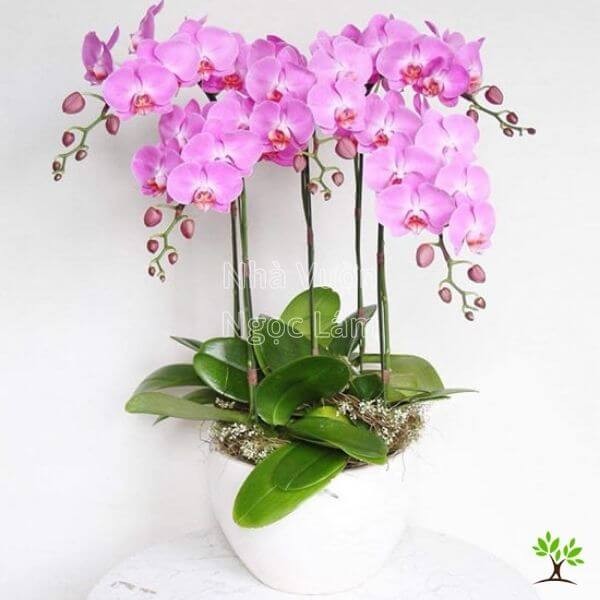 Orchid expert examining the roots of a Phalaenopsis orchid plant
Orchid expert examining the roots of a Phalaenopsis orchid plant
Phalaenopsis orchids are moisture-loving plants, with optimal humidity ranging from 50-80%. If growing the plant in a location with naturally low humidity, consider placing it in a sheltered area to reduce root drying due to evaporation.
When potting this type of orchid, it’s beneficial to layer some pebbles or gravel at the bottom of the pot. This helps stabilize the plant and acts as a safeguard against root rot if you accidentally overwater. Phalaenopsis orchids can be somewhat sensitive about watering, so using a spray bottle to mist the plant can help avoid giving too little or too much water, which can be fatal.
During hot summer weather, you may need to water the plant about 2-3 times per day. In winter, watering may only be necessary about once every 10 days. The best time to water is midday, allowing the leaves to dry by evening. Leaving water on the leaves overnight can lead to rot. Therefore, it’s best to adjust watering frequency seasonally, based on the plant’s needs and the type of growing media used.
Fertilization Requirements
The secret to getting your Phalaenopsis orchid to bloom successfully often lies in the timing of fertilization. When the plant starts to develop a flower spike, you should apply an NPK fertilizer with a high phosphorus and potassium ratio, such as 6-30-30, diluted at a rate of approximately 2 grams per liter of water. Watering the base of the plant every 7-10 days with this solution can lead to larger, longer-lasting flowers with more vibrant colors.
During summer and the plant’s active growth phase, fertilize regularly. Conversely, in winter, less fertilizer is needed as the plant uses fewer nutrients. Always water the plant thoroughly before applying fertilizer. A balanced NPK fertilizer, such as 14-14-14, is excellent for general growth. For plants that are blooming, use a fertilizer with a higher phosphorus content, equivalent to an NPK ratio like 10-30-20.
Once the orchid is in full bloom, stop fertilizing. When the flowers are nearly finished, cut off the spent flower stalk to conserve energy for the plant. If the flower stalk is still green, cut it back about 10-12cm (4-5 inches) above a node (a small bump on the stalk) to encourage the formation of a new flower spike. After cutting the stalk, fertilize with a high-nitrogen NPK formula, such as 30-10-10, to provide nutrients for the next blooming cycle.
Common Phalaenopsis Orchid Diseases
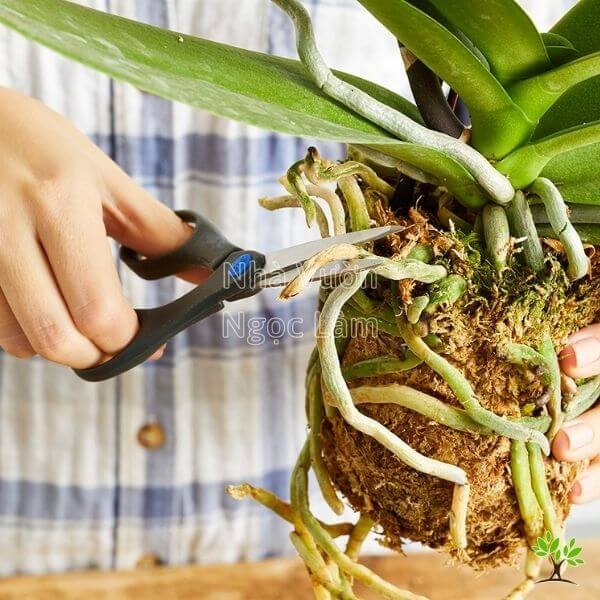 A close-up shot of a Phalaenopsis orchid leaf showing signs of spots and disease
A close-up shot of a Phalaenopsis orchid leaf showing signs of spots and disease
Phalaenopsis orchids thrive in humid environments with limited direct sunlight, conditions very suitable for the growth of fungi, mold, and pests. Therefore, close monitoring is necessary to implement preventive measures promptly. Generally, diseases in these plants fall into three groups: those caused by fungi, bacteria, and pests.
Fungal Diseases
- Black Rot: Caused by the fungus Phytophthora palmivora. This disease often occurs in summer when temperatures and humidity are high, or in poorly ventilated greenhouses. The disease progresses very quickly, causing stems and roots to rot. It spreads when watering, as fungal spores cling to water droplets and are dispersed to other plants. Spores primarily infect through wounds on leaves, stems, or roots, leading to root rot and leaf drop.
- Prevention: Ensure good airflow and ventilation in the growing area. Avoid creating wounds on the plant when potting or repotting. Sterilize any injured areas.
- Management: Avoid exposing infected plants to rain. Carefully manage daily watering. Severely infected plants should be removed to prevent spread. Young, infected plants should be discarded along with their growing media.
- Anthracnose: Caused by fungi like Colletotrichum. This fungus primarily affects older or weak leaves. Symptoms include circular brown-black spots with smaller yellowish or brownish rings in the center. This fungus thrives at 22-25°C (72-77°F) and is less common in summer.
- Prevention & Management: Use appropriate fungicides as needed and improve air circulation.
- White Mold: This disease damages stems and roots, causing them to rot. Early symptoms resemble soft rot or brown rot, but white fungal threads later appear on the lesions, followed by black spores, leading to stem rot and death.
- Prevention: Sterilize growing media before use. Keep the growing environment clean. Remove infected plants immediately to prevent spread.
- Management: Apply appropriate fungicides.
- Sooty Mold: Commonly found in gardens lacking sufficient light and ventilation. It’s often linked to infestations by sap-sucking pests like aphids or whiteflies, as the mold grows on the sugary honeydew they secrete on leaves, stems, or flower stalks.
- Effect: Reduces photosynthesis and makes the plant look unsightly.
- Prevention: Control pest infestations.
- Management: Gently wipe leaves clean with water using a soft cloth. Apply an appropriate fungicide.
- Yellow Leaves, Flower Drop: Symptoms appear on the leaf stalk as light gray spots of various shapes, later with light brown fungal spores. Subsequently, leaves yellow and drop.
- Prevention: Ensure good airflow. Dispose of fallen flower stalks and flowers.
- Management: Periodically spray with an appropriate fungicide solution.
Bacterial Diseases
- Soft Rot: Caused by the bacterium Pseudomonas gladioli. This disease spreads very rapidly; young plants can die within 2-3 days of infection. Symptoms start as water-soaked translucent spots that quickly enlarge. When infected leaves are torn during watering, fertilizing, or handling, the bacteria spread to healthy leaves, accelerating transmission.
- Treatment: There is no cure. Infected plants must be destroyed immediately to prevent spread.
- Prevention: Periodically spray with appropriate antibacterial agents (like antibiotics). Avoid overcrowding plants and maintain good ventilation. Stop watering for a few days after treatment.
- Brown Rot: Caused by the bacterium Erwinia carotovora. Plants can die within 2-3 days of infection, especially in the rainy season, as this bacterium thrives in hot, humid conditions and when water remains on leaves. Symptoms include water-soaked, greenish spots that enlarge, often with dark brown rings around them, causing Phalaenopsis leaves to yellow and drop.
- Distinction: Unlike soft rot, the tissue in brown rot often remains firm initially, making it hard to distinguish in soft-leaved plants.
- Spread & Development: Bacteria easily spread during care and watering. Spread rate is slower than soft rot, but it’s difficult to eradicate. Often affects young or old plants. Develops rapidly in late spring and early summer.
- Management: Early detection is crucial. Periodically spray Phalaenopsis orchids with appropriate antibacterial agents. Immediately cut off infected parts upon detection. Soak the cut leaf in a bactericide solution for 1-2 hours. Apply lime to the cut wound and spray with an antibacterial agent. Stop watering for a few days after treating infected plants.
- Virus Diseases: Common viruses affecting orchids include ORST, Orchid Strain TMV, CYMV, and CMV. These diseases are mainly spread by insects, friction between leaves, or through wounds created during care. Plants infected with viruses often show necrotic spots, leaf mottling with yellow-brown patches, and flower color changes.
- Treatment: Currently, there is no cure for viral diseases. Infected plants must be destroyed immediately.
- Prevention: Control harmful insects in the growing area. Sterilize care tools (pruners, etc.). Plant varieties that are certified virus-free.
Common Insect Pests
- Grasshoppers: Often fly in from surrounding grassy or vegetated areas, appearing in summer and fall. They chew on leaves, flower stalks, and petals, damaging the plant and reducing its value.
- Prevention: Keep the area around the orchids clean of weeds and tall grass.
- Management: Use appropriate insecticides.
- Thrips (Thrips palmi): These insects bite young leaves and flowers. They are mainly problematic during the blooming period. Thrips prefer to hide in flowers, suck sap, and lay eggs. When nymphs hatch, they continue to feed on the plant. Infestation leads to withered petals and buds, deformed flowers, and white spots or color changes on petals.
- Effect on leaves: After flowers open, thrips may move to young leaves, sucking sap and creating brown spots, deforming the leaves.
- Prevention & Management: Traditional pest control methods or using appropriate insecticides.
- Other Common Pests: Aphids, scale insects, snails, mites, whiteflies are also common pests affecting Phalaenopsis orchids.
- Prevention: Avoid overcrowding plants, ensure good ventilation in the growing area, keep surrounding areas clean to eliminate hiding places for pests.
- Management: Periodically spray with appropriate insecticides.
Stimulating Phalaenopsis Orchids to Bloom
Encouraging orchids to bloom at a specific time, perhaps for a holiday or event, is a common goal for growers. To achieve this, you need to understand the timing and adjust care practices to stimulate flower spike development at the right moment.
From the time a Phalaenopsis orchid develops a flower spike until all the flowers on the stalk are fully open, it takes about two months. Additionally, orchids typically initiate flower spikes when the weather begins to cool slightly. Since Phalaenopsis has a long blooming period, you can aim to trigger spike development about one and a half months before your desired bloom time to ensure the flowers are fully open when you want them. Knowing the timeframe, the key is to adjust your care routine, monitor temperatures, and fertilize to encourage the plant to form a flower spike around late autumn or early winter to bloom by the target date.
To ensure blooming, select mature Phalaenopsis plants that have finished growing new leaves and have at least 3-4 pairs of leaves. Once you’ve chosen healthy plants, you can start applying an NPK fertilizer with a high phosphorus and potassium ratio, such as 10-30-20. This type of fertilizer encourages flowering. Apply this fertilizer weekly at a rate of approximately 0.5-1g diluted in 4 liters of water to promote rapid spike development. Continue this application consistently for about 3-4 weeks, and you should start to see the plant pushing out a flower spike.
When the flower spike is about 2-3cm (around 1 inch) long, switch to a foliar fertilizer with a higher potassium content, such as NPK 15-20-30. Spray this weekly to help the spike grow strong and long quickly. This type of fertilizer also helps produce larger flowers with better color and longer lasting blooms, and can reduce the risk of flower rot. Maintain this consistent care for 45-50 days. By the time your target bloom period arrives, the first flowers should be opening, and the display will be in full glory for the following couple of months.
Frequently Asked Questions About Growing Phalaenopsis Orchids
What is the Meaning of the Phalaenopsis Orchid?
The Phalaenopsis orchid is one of the longest-lasting blooming orchids and is relatively adaptable to different climates and weather conditions, making it widely grown worldwide. In Europe, it is often seen as a gift of love, exchanged between partners to express deep, intense affection.
Historically, this flower was favored by royalty and nobility for its elegant, enchanting beauty and the meticulous care it required, especially rare varieties which held significant economic value. Beyond its beauty, the Phalaenopsis orchid symbolizes prosperity, wealth, and a bright future in Feng Shui, believed to attract fortune and promote a cheerful, peaceful spirit. Therefore, many people choose to display a pot in their home during celebratory seasons to bring wealth and luck for the coming year.
Furthermore, each flower color carries unique and distinct meanings:
- White Phalaenopsis Orchid: Symbolizes purity, beauty, elegance, as well as wealth and humility. It represents a fresh start. Gifting a white orchid signifies a wish to begin a new life full of good hopes with the recipient.
- Red Phalaenopsis Orchid: Represents passionate, vibrant love like a flame. It is also the color of power and conquest. Gifting this color expresses a strong desire for a deeper relationship and shows how much you love the other person.
- Yellow Phalaenopsis Orchid: Symbolizes prosperity, wealth, and luck. It also conveys wishes for success in career and a fortunate beginning. This is a suitable gift for family, friends, or business partners/clients.
- Purple Phalaenopsis Orchid: The color of loyalty, as well as elegance and royal power. Gifting it to a loved one expresses everlasting love regardless of the future. It’s also a suitable gift for managers or superiors as a sign of admiration and respect.
- Pink Phalaenopsis Orchid: Represents gentleness, peace, joy, and happiness. This flower color symbolizes a beautiful and pure love that is not overly intense but peaceful and full of happiness.
- Blue Phalaenopsis Orchid: A relatively rare color, representing the sky and sea, signifying tolerance, peace, and a touch of spirituality. This color is often displayed in temples and serene places.
- Orange Phalaenopsis Orchid: The color of warmth and enthusiasm. Not as dazzling as red or gentle as pink, but full of energy and passion like youthful vitality.
The Phalaenopsis orchid is a beautiful flower – elegant, captivating, yet maintaining a graceful character. It also has a longer blooming life than many other flowers and brings many positive meanings of luck. While perhaps a bit “high-maintenance,” it’s not overly difficult to grow. We wish you success in cultivating a beautiful pot of Phalaenopsis orchids using readily available and easy-to-find materials! Find the right supplies for your Phalaenopsis journey at Biogarden.asia.



